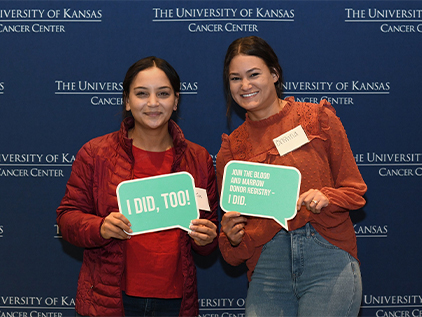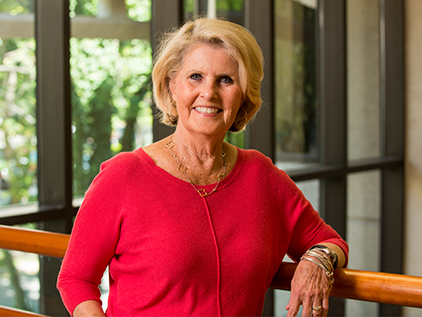- Home
- Types & Treatments
- Blood & Marrow Transplant
- Becoming a Donor
Blood and Marrow Transplant
Becoming a BMT Donor
Stem cell donors are crucial to a successful blood and marrow transplant. Their donation of marrow or peripheral blood stem cells helps save the lives of thousands of critically ill patients.
Anyone age 18-40 who meets the required health guidelines and is willing to donate to any patient in need can register to become a donor. Everyone on the registry is critical to saving lives. For all registry members, the most important thing you can do is stay committed, so if you’re selected as a match for a patient, be sure you’re ready to move forward.
The only BMT patients who do not require a donor are those who can use their own stem cells for transplant (autologous stem cell transplant). All other BMT patients require stem cells from a donor with matching tissue. About 70% of bone marrow transplant patients do not have a fully matched donor in their family and turn to the registry to find an unrelated donor.
If you need a stem cell transplant, you are not responsible for finding your own donor. If you require a matching donor for BMT, your transplant team at The University of Kansas Cancer Center will find a donor for you. If one of your siblings is a match, he or she can donate. If not, we will search the Be The Match Registry® to find a matching unrelated donor. Every donor search through Be The Match provides access to more than 39 million potential donors on the U.S. and global registries.
All donors, including relatives, receive a thorough physical exam. This may include laboratory blood tests, MRI and a bone scan. This ensures your safety as well as the transplant recipient’s safety.

Guidelines to donate
To become a bone marrow or stem cell donor, you must join the Be The Match Registry, the most diverse marrow and stem cell registry in the world. To join, you must meet specific medical requirements that include restrictions on age and general health to determine if you are eligible to be a donor.
Your tissue type, determined by a cheek cell swab, is stored when you join the registry, and you will donate marrow or stem cells only if you are determined to be a match for someone in need of a transplant.
Questions and answers about stem cell donation
Levi Korneli Be The Match Story
Stem cell donation myths and facts
MYTH: All donations involve surgery.
FACT: The majority of donations do not involve surgery. Today, the patient’s doctor most often requests a peripheral blood stem cell (PBSC) donation, which is nonsurgical. The second way of donating is marrow donation, which is a surgical procedure. In each case, donors typically go home the same day they donate.
MYTH: Donating is painful and involves a long recovery.
FACT: There can be uncomfortable but short-lived side effects of donating PBSC. Due to taking a drug called filgrastim for 5 days leading up to donation, PBSC donors may have headaches, joint or muscle aches or fatigue. PBSC donors are typically back to their normal routine in 1-2 days.
Those donating marrow receive general or regional anesthesia, so they feel no pain during donation. Marrow donors can expect to feel some soreness or discomfort in their lower back for a few days or weeks. Most marrow donors are back to their normal activities in 2-7 days.
MYTH: Donating is dangerous and weakens the donor.
FACT: Though no medical procedure is without risk, there are rarely any long-term side effects to becoming a bone marrow donor. Be The Match carefully prescreens all donors to ensure they are healthy and the procedure is safe for them. We also provide support and information every step of the way. Because only 5% or less of a donor’s marrow is needed for a successful transplant, the donor’s immune system stays strong and the cells replace themselves within 4-6 weeks.
MYTH: In bone marrow donation, pieces of bone are removed from the donor.
FACT: No pieces of bone are required for marrow donation. To save the patient’s life, a successful transplant needs only the liquid marrow found inside the donor’s pelvic bone.
MYTH: Donors have to pay to donate.
FACT: Donors never pay to donate. Be The Match Registry will reimburse travel costs and may reimburse other costs on a case-by-case basis, including meals and travel for the donor and one companion. Medical costs for the donation procedure will be covered by either the receiving patient’s medical insurance or Be The Match.

Rising to the challenge
Anne Holzbeierlein was diagnosed with acute myeloid leukemia (AML) and needed a bone marrow transplant. Thanks to a clinical trial, she's cancer-free.
Anne's story
Request your appointment today.
To make an appointment at The University of Kansas Cancer Center, call 913-588-1227.